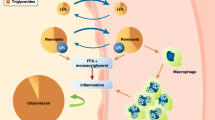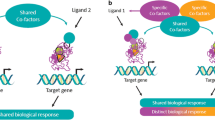Abstract
The peroxisome proliferator-activated receptor (PPAR) family of genes plays a major role in metabolic regulation. Unfortunately, the results of two recent, large event trials of PPAR agonists have been mixed. High rates of crossover to statin use confound the interpretation of the Fenofibrate Intervention and Event Lowering in Diabetes (FIELD) trial, which found a less than expected reduction in coronary and stroke events with fenofibrate. Of concern, nonsignificant increases in coronary and sudden deaths, thrombotic events, and pancreatitis occurred in the fenofibrate group. The PROspective pioglitAzone Clinical Trial In macroVascular Events (PROACTIVE) also found a reduction in coronary and stroke events with pioglitazone compared with placebo in a population with diabetes and cardiovascular disease, but this benefit was counterbalanced by an increase in congestive heart failure as well as symptomatic edema. Further research is needed to determine the role of PPAR agonists in the prevention of cardiovascular disease.
Similar content being viewed by others
References and Recommended Reading
Evans R, Barish G, Wang YX: PPARS and the complex journey to obesity. Nat Med 2004, 10:1–7.
Lefebvre P, Chinetti G, Fruchart JC, Staels B: Sorting out the roles of PPAR{alpha} in energy metabolism and vascular homeostasis. J Clin Invest 2006, 116:571–580.
Semple RK, Chatterjee VK, O’Rahilly S: PPAR{gamma} and human metabolic disease. J Clin Invest 2006, 116:581–589.
Barish GD, Narkar VA, Evans RM: PPAR{delta}: a dagger in the heart of the metabolic syndrome. J Clin Invest 2006, 116:590–597.
Wang YX: Peroxisome-proliferator-activated receptor delta activated fat metabolism to prevent obesity. Cell 2003, 113:159–170.
Howard BV, Rodriguez BL, Bennett PH, et al.: Prevention Conference VI: Diabetes and Cardiovascular Disease: Writing Group I: Epidemiology. Circulation 2002, 105:132e-137.
Grundy SM: Small LDL, atherogenic dyslipidemia, and the metabolic syndrome. Circulation 1997, 95:1–4.
Dormandy J, Charbonnel B, Eckland D, et al.: Secondary prevention of macrovascular events in patients with type 2 diabetes in the PROactive Study (PROspective pioglitAzone Clinical Trial In macroVascular Events): a randomised controlled trial. Lancet 2005, 366:1279–1289.
Robinson JG, Smith B, Maheshwari N, Schrott H: “Pleiotropic” effects of statins: Benefit beyond cholesterol reduction? A meta-regression analysis. J Am Coll Cardiol 2005, 46:1855–1862.
Robins SJ, Collins D, Wittes JT, et al.: Relation of gemfibrozil treatment and lipid levels with major coronary events: VA-HIT: a randomized controlled trial. JAMA 2001, 285:1585–1591.
Jones PH, Davidson MH, Stein EA, et al.: Comparison of the efficacy and safety of rosuvastatin versus atorvastatin, simvastatin, and pravastatin across doses (STELLAR Trial). Am J Cardiol 2003, 92:152–160.
Rubins H, Robins S, Collins D, et al.: Gemfibrozil for the secondary prevention of coronary heart disease in men with low levels of high-density lipoprotein cholesterol. Veterans Affairs High-density Lipoprotein Cholesterol Intervention Trial Study Group. N Engl J Med 1999, 341:410–418.
Coronary Drug Project: Clofibrate and niacin in coronary heart disease. JAMA 1975, 231:360–380.
Committee of Principal Investigators: A co-operative trial in the primary prevention of ischaemic heart disease using clofibrate. Br Heart J 1978, 40:1069–1118.
Frick M, Heinonen O, Huttenen J, et al.: Efficacy of gemfibrozil in dyslipidaemic subjects with suspected heart disease. An ancillary study in the Helsinki Heart Study frame population. Ann Med 1993, 25:41–45.
Heinonen O, Huttunen J, Manninen V, et al.: The Helsinki Heart Study: Coronary heart disease incidence during an extended follow-up. J Intern Med 1994, 235:41–49.
The BIP Study Group: Secondary prevention by raising HDL cholesterol and reducing triglycerides in patients with coronary artery disease. The Bezafibrate Infarction Prevention (BIP) Study. Circulation 2000, 102:21–27.
Cholesterol Treatment Trialists’ (CTT) Collaborators: Efficacy and safety of cholesterol-lowering treatment: prospective meta-analysis of data from 90,056 participants in 14 randomised trials of statins. Lancet 2005, 366:1267–1278.
Luc G, Jacob N, Bouly M, et al.: Fenofibrate increases homocystinemia through a PPAR-alpha-mediated mechanism. J Cardiovasc Pharmacol 2004, 43:452–453.
Mayer O, Åimon J, Holubec L, et al.: Fenofibrate-induced hyperhomocysteinemia may be prevented by folate co-administration. Eur J Clin Pharmacol 2003, 59:367–371.
The Heart Outcomes Prevention Evaluation I. Homocysteine lowering with folic acid and B vitamins in vascular disease. N Engl J Med 2006, 354:1567–1577.
Westphal S, Dierkes J, Luley C: Effects of fenofibrate and gemfibrozil on plasma homocysteine. Lancet 2001, 358:39–40.
Rubins HB, Robins SJ, Collins D, et al.: Diabetes, plasma insulin, and cardiovascular disease: Subgroup analysis from the Department of Veterans Affairs High-Density Lipoprotein Intervention Trial (VA-HIT). Arch Intern Med 2002, 162:2597–2604.
DAIS Study Group: Effect of fenofibrate on progression of coronary artery disease in type 2 diabetes: the Diabetes Atherosclerosis Intervention Study, a randomised study. Lancet 2001, 357:905–910.
National Cholesterol Education Panel: Third Report of the National Cholesterol Education Program (NCEP) Expert Panel on Detection, Evaluation, and Treatment of High Blood Cholesterol in Adults (Adult Treatment Panel III) Final Report. Circulation 2002, 106:3143–3421.
Heart Protection Study Collaborative Group: MRC/BHF Heart Protection Study of cholesterol-lowering with simvastatin in 5963 people with diabetes: a randomised placebo-controlled trial. Lancet 2003, 361:2005–2016.
Calhoun H, Betteridge D, Durrington P, et al.: Primary prevention of cardiovascular disease with atorvastatin in type 2 diabetes in the Collaborative Atorvastatin Diabetes Study (CARDS): multicentre randomised placebo-controlled trial. Lancet 2004, 364:685–696.
Shepherd J, Barter P, Carmena R, et al.: Effect of lowering LDL cholesterol substantially below currently recommended levels in patients with coronary heart disease and diabetes: The Treating to New Targets (TNT) study. Diabetes Care 2006, 29:1220–1226.
ACCORD purpose; June 30, 2006. http://www.accordtrial.org. Accessed July 12, 2006.
Jones PH, Davidson MH: Reporting rate of rhabdomyolysis with fenofibrate + statin versus gemfibrozil + any statin. Am J Cardiol 2005, 95:120–122.
Robinson JG, Stone N: Antiatherosclerotic and antithrombotic effects of omega-3 fatty acids Am J Cardiol 2006, 98(4 Suppl 1):39i-49i.
Wang C, Harris WS, Chung M, et al.: n-3 Fatty acids from fish or fish-oil supplements, but not {alpha}-linolenic acid, benefit cardiovascular disease outcomes in primary- and secondary-prevention studies: a systematic review. Am J Clin Nutr 2006 84:5–17.
Dormandy J, Charbonnel B, Eckland D, et al.: Secondary prevention of macrovascular events in patients with type 2 diabetes in the PRO active Study (PRO spective pioglitAzone Clinical Trial in macroVascular Events): a randomised controlled trial. Lancet 2005, 366:1279–1289.
Nesto RW, Bell D, Bonow RO, et al.: Thiazolidinedione use, fluid retention, and congestive heart failure: a consensus statement from the American Heart Association and American Diabetes Association. Circulation 2003, 108:2941–2948.
Selvin E, Marinopoulos S, Berkenblit G, et al.: Meta-analysis: glycosylated hemoglobin and cardiovascular disease in diabetes mellitus. Ann Intern Med 2004, 141:421–431.
Gotto AM Jr, Brinton EA: Assessing low levels of high-density lipoprotein cholesterol as a risk factor in coronary heart disease: a working group report and update. J Am Coll Cardiol 2004, 43:717–724.
Goldberg RB, Kendall DM, Deeg MA, et al.: A Comparison of lipid and glycemic effects of pioglitazone and rosiglitazone in patients with type 2 diabetes and dyslipidemia. Diabetes Care 2005, 28:1547–1554.
Koeffler HP: Peroxisome proliferator-activated receptor gamma and cancers. Clin Cancer Res 2003, 9:1–9.
Takeda Pharmaceuticals. Actos [piogltiazone hydrochloride] prescribing information. http://www.actos.com/sub_sec1_what_actos.asp. Accessed July 13, 2006.
Nathan DM, Buse JB, Davidson MB, et al.: Management of hyperglycemia in type 2 diabetes: A consensus algorithm for the initiation and adjustment of therapy: A consensus statement from the American Diabetes Association and the European Association for the Study of Diabetes. Diabetes Care 2006, 29:1963–1972.
Viberti G, Kahn SE, Greene DA, et al.: A Diabetes Outcome Progression Trial (ADOPT): an international multicenter study of the comparative efficacy of rosiglitazone, glyburide, and metformin in recently diagnosed type 2 diabetes. Diabetes Care 2002, 25:1737–1743.
The Dream Trial Investigators: Rationale, design and recruitment characteristics of a large, simple international trial of diabetes prevention: the DREAM trial. Diabetologia 2004, 47:1519–1527.
Abraira C, Duckworth W, McCarren M, et al.: Design of the cooperative study on glycemic control and complications in diabetes mellitus type 2: Veterans Affairs Diabetes Trial. J Diabetes Complications 2003, 17:314–322.
Brooks MM, Frye RL, Genuth S, et al.: Hypotheses, design, and methods for the Bypass Angioplasty Revascularization Investigation 2 Diabetes (BARI 2D) trial. Am J Cardiol. 2006, 97(Suppl 1):9–19.
Home P, Pocock S, Beck-Nielsen H, et al.: Rosiglitazone Evaluated for Cardiac Outcomes and Regulation of Glycaemia in Diabetes (RECORD): study design and protocol. Diabetologia 2005, 48:1726–1735.
Nissen SE, Wolski K, Topol EJ: Effect of muraglitazar on death and major adverse cardiovascular events in patients with type 2 diabetes mellitus. JAMA 2005, 294:2581–2586.
Kendall DM, Rubin CJ, Mohideen P, et al.: Improvement of glycemic control, triglycerides, and HDL cholesterol levels with muraglitazar, a dual ({alpha}/{gamma}) peroxisome proliferator-activated receptor activator, in patients with type 2 diabetes inadequately controlled with metformin monotherapy: A double-blind, randomized, pioglitazone-comparative study. Diabetes Care 2006, 29:1016–1023.
Tenenbaum A, Motro M, Fisman E: Dual and pan-peroxisome proliferator-activated receptors (PPAR) co-agonism: the bezafibrate lessons. Cardiovasc Diabetology 2005, 4:14.
The Diabetes Prevention Program Research Group: Prevention of type 2 diabetes with troglitazone in the Diabetes Prevention Program. Diabetes 2005, 54:1150–1156.
Author information
Authors and Affiliations
Corresponding author
Rights and permissions
About this article
Cite this article
Robinson, J.G. Update on PPAR agonists: The clinical significance of FIELD and PROACTIVE. Curr Atheroscler Rep 9, 64–71 (2007). https://doi.org/10.1007/BF02693930
Issue Date:
DOI: https://doi.org/10.1007/BF02693930




